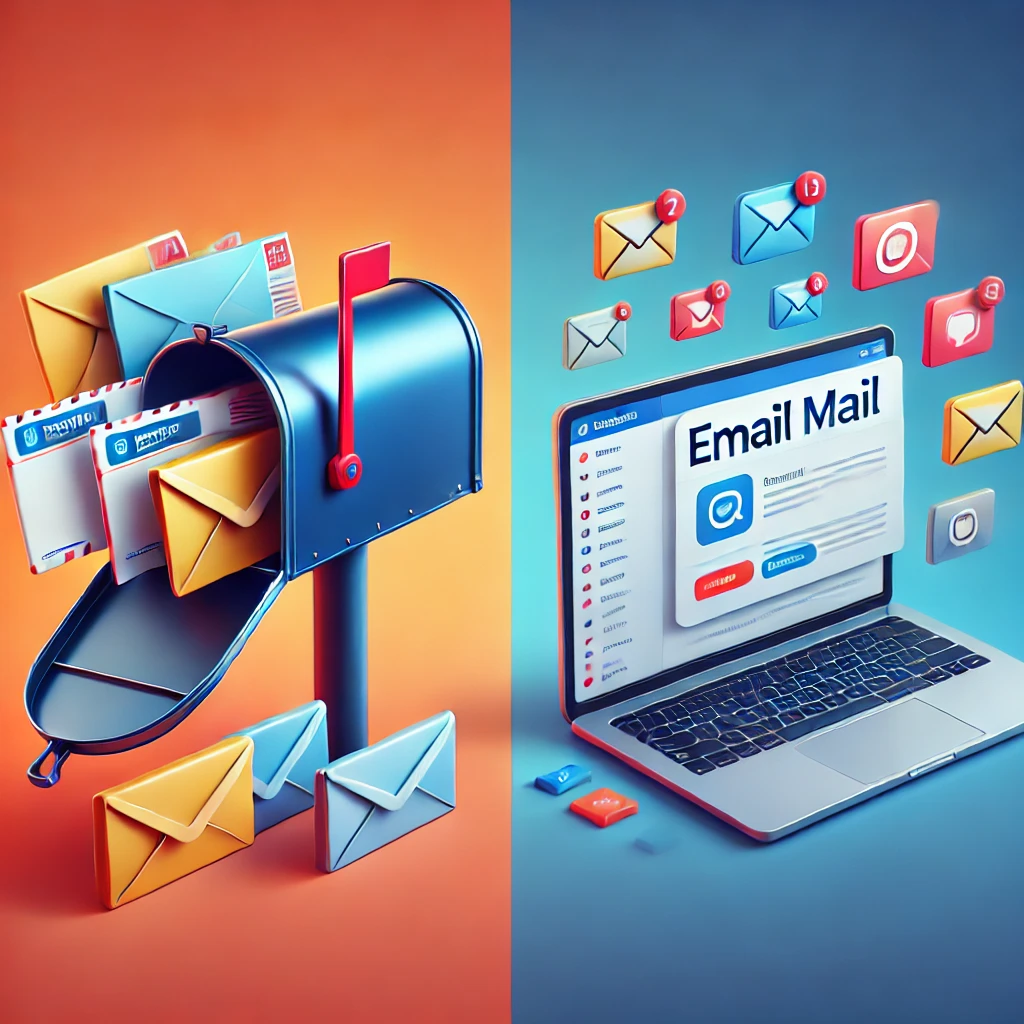Direct Mail vs Email Marketing: Which Drives Better Results?
In the ever-evolving world of marketing, two methods have stood the test of time – direct mail and email marketing. But which one is right for your business?
Is it the tangible allure of direct mail that leaves a lasting impression, or the swift, cost-effective reach of email marketing that can connect with a large audience in a click?
In this comprehensive comparison, we’ll delve into the pros, cons, and differences between these two marketing channels.
We’ll explore everything from response rates to the role of automation, and even how to bolster your campaigns with a multichannel approach. Whether you’re a seasoned marketer or a small business owner, this guide will help you navigate the complexities of direct mail and email marketing, enabling you to make informed decisions that drive results.
So, buckle up and let’s dive into the world of mail and email marketing!
Understanding Direct Mail and Email Marketing
In the vast landscape of marketing, two strategies often stand out for their effectiveness and reach: direct mail and email marketing. Both methods have proven their worth in different scenarios, each offering unique benefits that can significantly impact a marketing campaign. This section aims to delve deeper into these two marketing channels, providing a comprehensive understanding of their workings, advantages, and potential drawbacks.
Whether you’re a seasoned marketer or a business owner exploring different marketing strategies, understanding the nuances of direct mail and email marketing can help you make informed decisions that align with your goals. Let’s embark on this journey of exploration, starting with a closer look at direct mail marketing.
What is Direct Mail Marketing?
Direct mail marketing is a time-tested and highly effective marketing method which involves the dispatch of physical promotional materials, such as postcards, brochures, or catalogs, directly to a potential customer’s mailbox. The personalized nature of this marketing channel allows for a tactile and intimate connection, setting it apart from the often impersonal outreach methods in the digital realm.
Though potentially more labor-intensive and pricier than email marketing, the impact of direct mail marketing can be profoundly convincing. Each piece of direct mail has the power to create a lasting impression that translates into consumer trust and credibility.Offering a real and premium experience, the digital marketing agency dubai is particularly favored when promoting higher-end products or services.
One of the other major strengths of direct mail marketing is its precision in reaching the desired demographic. It can be easily tailored in order to optimize resonance with a specific age group, income bracket, or geographic location, thus enhancing the likelihood of conversion.
What is Email Marketing?
Email marketing, now a significant cornerstone of digital marketing strategy, is a mode of communication that involves sending digital messages directly to a recipient’s email inbox. It is a particularly flexible way of reaching a large customer base quickly and efficiently. Similar to sending out physical mailers, businesses use email marketing campaigns to promote their products, unveil new services, trigger a sense of urgency with limited-time offers, and even to nurture relationships with their customers.
Tracking the success of an email marketing campaign becomes easier as marketers gain immediate access to metrics such as open rates and response rates. However, standing out in a recipient’s crowded inbox could pose a bit of challenge, especially when spam filters occasionally become an obstacle.
Nonetheless, email marketing remains an excellent marketing method. It is especially powerful when businesses need to convey important information or engage with a broad audience swiftly and effectively. Personalizing email content to resonate with specific audience segments can potentially increase engagement rates and drive conversions.
In a nutshell, email marketing offers a cost-effective solution that allows businesses to maintain consistent contact with their customers, right at the comfort of their inbox. The right strategy and the optimal use of this marketing channel can indeed be beneficial to the right brand at the right time.
Comparing Direct Mail and Email Marketing: Pros and Cons
In the world of marketing, the debate between direct mail and email marketing is a long-standing one. Both have their unique strengths and weaknesses, and understanding these can help marketers make informed decisions. This section will delve into the pros and cons of both direct mail and email marketing, providing a comprehensive comparison to help you decide which method suits your business needs best.
The comparison will not only highlight the pros and cons but also the differences between these two marketing strategies. Whether you’re leaning towards the traditional approach of direct mail or the digital convenience of email marketing, this comparison will provide valuable insights. Let’s dive into the world of email vs direct mail marketing.
Pros and Cons of Direct Mail Marketing
✅Tangibility: Unlike its digital counterpart, direct mail marketing offers a sense of tangibility. Customers can hold in their hands, making the interaction more real and personal. This physicality can create a stronger impact and connection with your brand.
✅Enhanced Memorability: According to studies, like the one by the Royal Mail Marketreach, direct mail has proved to be more memorable than an email. This contributes to your brand recognition, which can drive your prospects to engage more with your brand.
✅Potential for Higher ROI: Despite being more expensive compared to email, direct mail marketing can potentially deliver a higher ROI. This is primarily because it permits you to target your audience more precisely, and compete with fewer businesses vying for the same customers’ attention.
✅Time-consuming: The process of designing, printing, and posting direct mail can be more time-consuming compared to sending an email. This extended timescale can prove to be a drawback, especially if you’re looking for quick results.
❌Costly: Direct mail entails costs related to design, printing, and postage. These costs can add up and make it a more expensive option than email marketing.
❌Environmentally Challenging: As we all become more eco-conscious, the environmental impact of direct mail can’t be ignored. Unlike emails, direct mail uses paper, posing a challenge to the environment. This can negatively influence customers who prioritize green practices.
Pros and Cons of Email Marketing
Here are the key pros and cons of email marketing:
✅Truly in-depth and accessible analytics. Platforms like Selzy provide real-time monitoring of an email campaign, allowing you to track if the email was received, opened, and what links were clicked.
✅Cost-effectiveness. You only pay for your email marketing platform, and often only when you’ve exceeded certain usage limits. Some platforms, like Selzy, even offer free services if your contact list is small.
✅Highly tactical A/B testing. Emails allow for cheap, thorough, and straightforward split testing, enabling data-driven marketing decisions to be made swiftly and with confidence.
❌Time-consuming. Email marketing requires a significant amount of focus and continuous analytics monitoring. Basic knowledge is not enough; creating automated sequences and maintaining them is a laborious task.
❌High competition. Your brand’s email can quickly get lost in a sea of promotional emails in a customer’s inbox, reducing its chance of being read.
Response Rates: Direct Mail vs Email Marketing
In the marketing world, the battle between direct mail and email marketing is a constant one. Both have their strengths and weaknesses, and understanding these can help marketers make informed decisions. One crucial aspect to consider is the response rate. This metric provides insight into how well your message resonates with your audience, whether it’s sent via a physical mail piece or an email campaign. Let’s delve into the intricacies of response rates in both direct mail and email marketing, and see how they stack up against each other.
Understanding Response Rates in Direct Mail
The phrase ‘response rate’ in direct mail refers to the number of recipients who engage in some action after receiving the mail piece. This could be anything from making a purchase, responding to a survey, or even visiting your company’s website. It’s an indispensable metric in assessing the effectiveness of your direct mail campaign.
The average response rate for direct mail campaigns can vary significantly and is affected by many factors. These could range from the quality of your mailing list, the attractiveness of your offer, and even the overall design and presentation of your mail piece.
In the realm of direct mail, a good response rate is generally regarded as anything over 3%. This might seem modest on the surface, but when you are reaching a large target market, the actual number of positive responses can indeed be significant.
To improve response rates, it’s necessary to refine and optimize your direct mail strategy continually. Get creative with your layout, offer exclusive deals, and ensure that you are presenting your audience with a tangible value proposition. Remember, the higher the response rate, the higher the success of your direct mail campaign.
Understanding Response Rates in Email Marketing
In the world of email marketing, the term “response rate” is typically replaced with “open rate.” This is quite simply the proportion of the audience who open the email after receiving it. The open rate depends on several factors, such as the quality of the email list, the relevance of the subject line, and the timing of the send out.
The average open rate in email marketing, however, is generally lower than the average response rate in direct mail. Why so? This is because an email campaign is easy to ignore amidst the hustle and bustle of a crowded inbox. A mail piece, on the other hand, is tangible and harder to overlook.
Ironically, despite the lower open rate, email marketing has the potential to reach a significantly larger audience than a direct mail campaign. With virtually everyone and their dog having an email account these days, the online space is ripe with potential contacts.
Understanding these nuances can be of significant help in establishing the best strategy for your target market. Yes, the field is vast and the competition is stiff, but comprehending the intricacies of email marketing response rates can give you the footing you need.
When to Use Direct Mail and Email Marketing
Choosing between direct mail and email marketing can be a daunting task. Both channels have their unique strengths and are suited to different scenarios. The key lies in understanding when to use direct mail and email marketing to maximize their potential.
In this section, we’ll delve into the ideal situations for employing these two marketing strategies. We’ll explore the circumstances where the tangible appeal of direct mail shines and the scenarios where the speed and efficiency of email marketing reign supreme. This will provide you with a clearer picture of how to effectively use direct mail and email in your marketing mix.
Ideal Scenarios for Direct Mail Marketing
- Scenario One: When you want to target a specific geographic area, using direct mail is a hip idea. For example, a local gym could send postcards to houses and businesses in its surrounding neighborhoods.
- Scenario Two: When you’re offering premium or niche products targeting a selective audience. Direct mail could help your product stand out and make an impactful first impression.
- Scenario Three: If you’re trying to leave a lasting impression, direct mail wins hands down. Unlike digital adverts that can easily get lost in the shuffle, a well-designed mail piece is more memorable.
- Scenario Four: When you are trying to evoke an emotive response from customers. With direct mail, you can include tangible items that create a sense of anticipation and excitement. For example, concert promoters might include a fan item in the direct mails to heighten the concert experience.
In these scenarios, direct mail can often outperform email marketing. It’s all about understanding when and how to use each tool in your marketing mix.
Ideal Scenarios for Email Marketing
- Promote Limited-Time Offers and Flash Sales: When there’s a need to instantaneously alert your audience about time-sensitive deals, email is your best bet.
- Lead Nurturing: Use email sequences to nurture leads, building relationships by providing valuable industry insights or company updates.
- Audience Segmentation: With email, you can segment your audience based on behavior, demographics, or engagement levels, allowing for personalized communication.
- High Volume Reach: If your objective is to connect with a sizable audience without shelling out a lot, email marketing is a cost-effective solution.
Remember, successful email marketing isn’t about bombarding customers with countless emails — it’s about delivering timely, personalized content that adds genuine value.
Combining Direct Mail and Email Marketing for a Multichannel Approach
In the world of marketing, the debate between direct mail and email marketing is a constant one. However, the real magic happens when these two powerful tools are combined. This section will delve into the concept of a multichannel approach, where direct mail and email marketing work hand in hand to create a more robust and effective campaign.
This approach not only broadens your reach but also caters to the diverse preferences of your audience. It’s a great way to ensure that your message is heard loud and clear, regardless of the platform your audience prefers. So, let’s explore how combining direct mail and email marketing can significantly bolster your campaign and attract a large audience.
Benefits of a Multichannel Marketing Approach
In today’s competitive marketing landscape, organizations are sometimes at loggerheads over choosing between direct mail vs email marketing. But advocating for one over the other isn’t optimal; instead, a multichannel approach that integrates both direct mail and email marketing can seriously bolster your campaign’s potential.
As the proverbial saying goes – don’t put all your eggs in one basket. Marketing via a single channel limits your reach to a certain demographic or platform. The beauty of a multichannel approach, combining direct mail and email, is that it allows you to span a more extensive spectrum, attracting a larger audience.
With this diversification, each channel complements the other, thus enhancing your campaign effectiveness. While direct mail can make a physical, appealing connection with the customer, an email can be timely, offering comfort and immediacy. Essentially, using direct mail and email together can help tap into different customer preferences, increasing the odds of campaign success.
How to Integrate Direct Mail and Email Marketing
When it comes to integrating direct mail and email marketing, the process calls for careful planning and well-thought-out strategies. This is not merely about sending out mails and emails randomly, rather, it requires understanding your specific audience and consequently tailoring your messages to them.
The first step to this integration is to start the campaign with a captivating direct mail piece. This should not just generate curiosity in the mind of your potential customer, but also create a memorable impression. The message of this mail piece should dovetail with the branding and overall goals of your campaign.
Once your direct mail is underway, begin deploying targeted emails to your audience. These emails should extend the conversation started by the direct mail. By providing additional value through the email channel, you can reinforce the main message of your campaign and keep your brand at the front of your audience’s mind.
Direct Mail vs Email Marketing: Making the Right Choice
In conclusion, both direct mail and email marketing have their unique strengths and weaknesses. The choice between the two largely depends on your specific business needs, target audience, and marketing goals.
While direct mail can create a lasting impression and reach a large audience, email marketing offers quick delivery, cost-effectiveness, and a smaller ecological footprint. A successful marketing strategy often involves a blend of different channels.
Integrating direct mail and email marketing can provide a comprehensive, multichannel approach that bolsters your campaigns. Ultimately, the key is to understand your audience, craft irresistible subject lines, and deliver valuable content that connects with your brand.
Whether you choose direct mail, email, or a combination of both, the goal is to engage your customers and drive them to action. Ready to elevate your marketing strategy? Visit Cactus Mailing to discover how we can help you create impactful direct mail and email campaigns that drive results!




